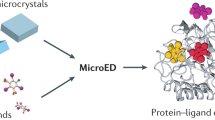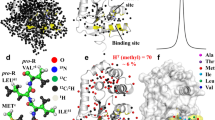Abstract
Circular dichroism (CD) is a useful technique for an assessment of DNA-binding mode, being a more accessible, low-resolution complement to NMR and X-ray diffraction methods. Ligand–DNA interactions can be studied by virtue of the interpretation of induced ligand CD signals resulting from the coupling of electric transition moments of the ligand and DNA bases within the asymmetric DNA environment. This protocol outlines methods to determine the binding mode and affinity of ligand–DNA interactions and takes approximately 7.5 h.
This is a preview of subscription content, access via your institution
Access options
Subscribe to this journal
Receive 12 print issues and online access
$259.00 per year
only $21.58 per issue
Buy this article
- Purchase on Springer Link
- Instant access to full article PDF
Prices may be subject to local taxes which are calculated during checkout



Similar content being viewed by others
References
Ardhammar, M., Nordén, B. & Kurucsev, T. DNA–drug interactions. in Circular Dichroism: Principles and Applications (eds. Berova, N., Nakanishi, K. & Woody, R.W.) 741–768 (John Wiley & Sons Inc., New York, 2000).
Eriksson, M. & Nordén, B. Linear and circular dichroism of drug–nucleic acid complexes. Methods Enzymol. 340, 68–98 (2001).
Nordén, B. & Kurucsev, T. Analysing DNA complexes by circular and linear dichroism. J. Mol. Recognit. 7, 141–155 (1994).
Rodger, A. & Nordén, B. Circular Dichroism and Linear Dichroism (eds. Compton, R.G., Davies, S.G. & Evans, J.) (Oxford University Press, Oxford, 1997).
Schipper, P.E., Norden, B. & Tjerneld, F. Determination of binding geometry of DNA-adduct systems through induced circular dichroism. Chem. Phys. Lett. 70, 17–21 (1980).
Rizzo, V. & Schellman, J.A. Matrix-method calculation of linear and circular dichroism spectra of nucleic acids and polynucleotides. Biopolymers 23, 435–470 (1984).
Lyng, R., Rodger, A. & Nordén, B. The CD of ligand–DNA systems. I. Poly(dG-dC) B-DNA. Biopolymers 31, 1709–1720 (1991).
Lyng, R., Rodger, A. & Nordén, B. The CD of ligand–DNA systems. 2. Poly(dA-dT) B-DNA. Biopolymers 32, 1201–1214 (1992).
Lyng, R., Härd, T. & Nordén, B. Induced CD of DNA intercalators: electric dipole allowed transitions. Biopolymers 26, 1327–1345 (1987).
Kubista, M., Akerman, B. & Nordén, B. Induced circular dichroism in nonintercalative DNA–drug complexes. Sector rules for structural applications. J. Phys. Chem. 92, 2352–2356 (1988).
Madison, V. & Schellman, J.A. Optical activity of polypeptides and proteins. Biopolymers 11, 1041–1076 (1972).
Bayley, P.M., Nielsen, E.B. & Schellman, J.A. The rotatory properties of molecules containing two peptide groups: theory. J. Phys. Chem. 73, 228–243 (1969).
Nordén, B. & Tjerneld, F. Structure of methylene blue–DNA complexes studied by linear and circular dichroism spectroscopy. Biopolymers 21, 1713–1734 (1982).
Kim, H.-K., Kim, J.-M., Kim, S.K., Rodger, A. & Nordén, B. Interactions of intercalative and minor groove binding ligands with triplex poly(dA).[poly(dT)]2 and with duplex poly(dA).poly(dT) and poly[d(A-T)]2 studied by CD, LD, and normal absorption. Biochemistry 35, 1187–1194 (1996).
Rodger, A., Taylor, S., Adlam, G., Blagbrough, I.S. & Haworth, I.S. Multiple DNA binding modes of anthracene-9-carbonyl-N1-spermine. Bioorgan. Med. Chem. 3, 861–872 (1995).
Rodger, A., Blagbrough, I.S., Adlam, G. & Carpenter, M.L. DNA binding of a spermine derivative: spectroscopic study of anthracene-9-carbonyl-N1-spermine with poly[d(G-C).(d(G-C)] and poly[d(A-T).d(A-T)]. Biopolymers 34, 1583–1593 (1994).
Řeha, D. et al. Intercalators. 1. Nature of stacking interactions between intercalators (ethidium, daunomycin, ellipticine, and 4′,6-diaminide-2-phenylindole) and DNA base pairs. Ab initio quantum chemical, density functional theory, and empirical potential study. J. Am. Chem. Soc. 124, 3366–3376 (2002).
Wilson, W.D. DNA and RNA intercalators. in DNA and Aspects of Molecular Biology Vol. 7 (ed. Kool, E.) (Elsevier Science Ltd., Oxford, 1999).
Tidwell, R.R. & Boykin, D.W. Dicationic DNA minor groove binders as antimicrobial agents. in DNA and RNA Binders: From Small Molecules to Drugs Vol. 2 (eds. Demeunynck, M., Bailly, C. & Wilson, W.D.) 416–460 (Wiley-VCH, Weinheim, Germany, 2003).
Neidle, S. DNA minor-groove recognition by small molecules. Nat. Prod. Rep. 18, 291–309 (2001).
Bishop, G.R. & Chaires, J.B. Characterization of DNA structures by circular dichroism. in Protocols in Nucleic Acid Chemistry Vol. 2 (eds. Beaucage, S.L., Bergstrom, D.E., Glick, G.D. & Jones, R.A.) 7.11.11–17.11.18 (John Wiley & Sons Inc., New York, 2002).
Haq, I., Chowdhry, B.Z. & Chaires, J.B. Singular value decomposition of 3-D DNA melting curves reveals complexity in the melting process. Eur. Biophys. J. 26, 419–426 (1997).
Drake, A.F. Circular dichroism. in Protein–Ligand Interactions: Structure and Spectroscopy A Practical Approach (eds. Harding, S.E. & Chowdhry, B.Z.) 123–168 (Oxford University Press, Oxford, 2001).
Weber, G. Energetics of ligand binding to proteins. Adv. Prot. Chem. 29, 1–83 (1975).
Qu, X. & Chaires, J.B. Analysis of drug–DNA binding data. Methods Enzymol. 321, 353–369 (2000).
Strat, D., Missailidis, S. & Drake, A.F. A novel methodological approach for the analysis of host–ligand interactions. ChemPhysChem. 8, 270–278 (2007).
Weber, G. Protein Interactions (Chapman & Hall, New York, 1992).
Ragazzon, P.A., Garbett, N.C. & Chaires, J.B. Competition dialysis: a method for the study of structural selective nucleic acid binding. Methods 42, 173–182 (2007).
Palumbo, M., Capasso, L., Palù, G. & Marcianimagno, S. Conformational aspects of drug–DNA interactions: studies on anthracycline antibiotics and psoralen derivatives. Proc. Int. Symp. Biomol. Struct. Int. Suppl. J. Biosci. 8, 689–697 (1985).
Dalgleish, D.G., Peacocke, A.R., Fey, G. & Harvey, C. The circular dichroism in the ultraviolet of aminoacridines and ethidium bromide bound to DNA. Biopolymers 10, 1853–1863 (1971).
Dahl, K.S., Pardi, A. & Tinoco, J. I. Structural effects on the circular dichroism of ethidium ion–nucleic acid complexes. Biochemistry 21, 2730–2737 (1982).
Aktipis, S. & Martz, W.W. Circular dichroism and temperature–optical density studies on the conformation of polynucleotide–ethidium bromide complexes. Biochemistry 13, 112–118 (1974).
Author information
Authors and Affiliations
Corresponding author
Rights and permissions
About this article
Cite this article
Garbett, N., Ragazzon, P. & Chaires, J. Circular dichroism to determine binding mode and affinity of ligand–DNA interactions. Nat Protoc 2, 3166–3172 (2007). https://doi.org/10.1038/nprot.2007.475
Published:
Issue Date:
DOI: https://doi.org/10.1038/nprot.2007.475
Comments
By submitting a comment you agree to abide by our Terms and Community Guidelines. If you find something abusive or that does not comply with our terms or guidelines please flag it as inappropriate.



